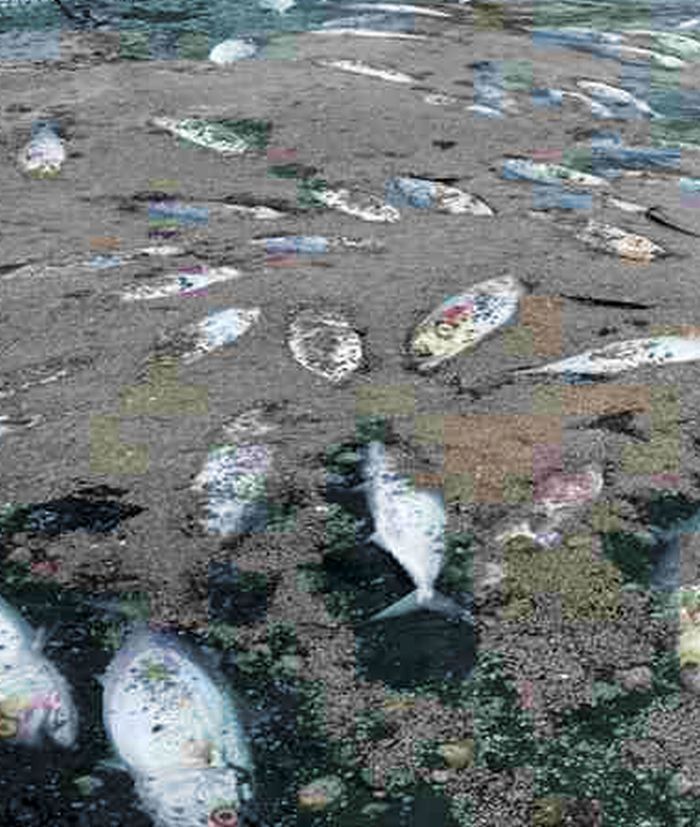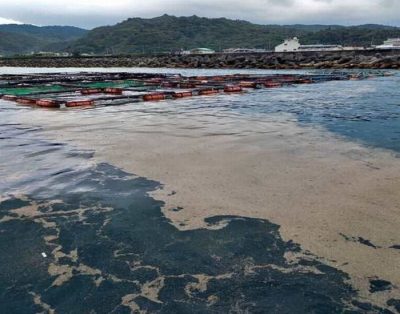Large amounts of fish are killed after swallowing pumice stones from undersea volcanic eruption, 14 Okinawan fisheries reeling from the damage as Okinawa and Japan coordinate on removal

Indian mackerel that were found dead in their fishery enclosures after swallowing pumice stones – October 25, in Hentona Harbor in Kunigami(photograph provided by the Kunigami Fishery Cooperative)
October 26, 2021 Ryukyu Shimpo
By Chie Tome
Due to an undersea volcanic eruption in the waters near the Ogasawara Islands creating a large amount of pumice stone, which is washing up on the beaches and in the harbors in Okinawa, it was learned by October 25 that 14 of the 37 fishing cooperatives in Okinawa have suffered damage from the stones washing ashore, according to the Okinawa Fishery Cooperative Association (JF Okinawa). Among these, Hentona Harbor in Kunigami reported that over 150 Indian Mackerel they had been raising in the harbor had died from swallowing the stones. The beaches all over the region are seeing the stones wash ashore and floating in the water, marring the scenery and effecting the marine leisure tourism industry as reservations are being cancelled.
According to a representative from JF Okinawa, only the Kunigani Fishery Cooperative is suffering serious damage at this time, but with a change in the direction of the wind as well as the tides, there is a possibility the area of the damage could spread.
Okinawa Prefecture is continuing their survey of pumice stone washing ashore, and are investigating methods for removing the stones. The investigators indicated that if they determine that the damage has had a substantial effect on the fishing industry, they can enact a response based on Japan’s National Government Defrayment Act for Reconstruction of Disaster-Stricken Public Facilities. “We will explain the situation at Hentona Harbor to the Japanese Fishery Agency, and coordinate with them.”
The pumice stones washing ashore were first confirmed at the end of September through the start of October on Minami-Daito Island, whereafter the stones rode the current towards Okinawa’s main island and surrounding area. At first the stones were mostly concentrated on the eastern coast of Okinawa’s main island, however over time they started to appear on the western coast as well, and were soon confirmed all over the Okinawan archipelago. It has also hindered fishing boats operations such as fears that the stones will cause engine trouble.
JF Okinawa confirmed the extent of the damage at each fishery cooperative from October 20-24, and pumice stones were confirmed in 14 of the fisheries’ jurisdictions: Kunigami, Nakijin, Motobu, Ih

Pumice stones floating on the surface of the water in Hentona Harbor, where Indian mackerel are raised (photograph provided by the Kunigami Fishery Cooperative)
eya, Ie, Onna, Katsuren, Yonashiro, Sashiki-Nakagusuku, Chinen, Minatogawa, Itoman, Kume Island, and Tonaki.
According to Kunigami Fishery secretary Takashi Higa, around 20 fishing boats regularly travel in and out of Hentona Harbor, but currently the harbor is clogged with floating pumice, and fishing has been suspended since October 18. Higa indicated, “This is the prime season for Mahi-mahi, but currently none are being caught. The estimated losses from this are around 1.5 million yen per day.” They have encouraged the fishery cooperative members to voluntarily restrain themselves from operating their fishing boats until they’ve established a forecast for the situation.
Katsuo Oshiro, a member of the Katsuren Fishery Cooperative in Uruma, a major producer of mozuku, voiced his concern, saying, “In preparation for the harvest in March, we start work on laying out the aquaculture nets in November. If there are large amounts of pumice on the surface of the water, there is a chance the mozuku will not be able to get enough nutrients.”
(English translation by T&CT and Sam Grieb)
Previous Article:Facing Serious Coral Damage and Parking Problems, Government Experiments with Limiting Leisure-Use of Okinawa’s Blue Cave
Next Article:Tokashiki celebrates two local women turning 97: Their secret to long life? – Farming
[Similar Articles]
- Mozuku aquaculture interrupted by pumice stones, expected to effect national supply
- “It looks like reclaimed land” as floating pumice inundates the coast of Motobu
- Pumice stone removal costs expected to exceed 1.6 billion yen, not including damage to fishing and tourism industries
- Fishing boat washes ashore in Okinawa 8 years after being swept away in 2011 Tohoku tsunami
- Okinawan tuna fishing boats have their trawl lines cut off 15 times
 Webcam(Kokusai Street)
Webcam(Kokusai Street)


